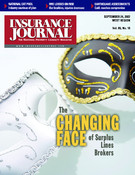Two years have passed since America’s most shocking wake-up call regarding the devastation that follows the force and fury of Mother Nature. Since that time, a variety of legislative proposals have been offered at the state and national levels to address the shortcomings of our financial infrastructure, our first responder programs and our personal attitudes toward catastrophe preparation and protection.
The two years since Katrina hit have brought more and more policymakers to the clear and unambiguous conclusion that the status quo is unacceptable, and that consumers and taxpayers deserve a better system.
Denying that a problem exists or offering as the solution to simply raise rates and hope for the best is unacceptable. The stakes are higher than ever. Reform is essential and inevitable.
We can do better. A stronger public-private partnership at the local, state and national levels is the best way to maximize the respective strengths of both the public and the private sectors. The establishment of a comprehensive, integrated solution that leverages the public-private partnership model would provide more protection at lower cost to consumers.
The good news is that the solution is gaining momentum, and congressional leaders have predicted that a bill will be considered by the full House of Representatives by the end of the year. The solution is being embraced by a growing number of representatives from across the nation, including those who represent catastrophe-prone regions and others who represent lower-risk states who want to put an end to the massive policyholder and taxpayer subsidies upon which the current system relies.
Reports show that the typical taxpaying American family paid more than $800 to cover costs associated with Hurricane Katrina. That is an enormous nationwide catastrophe tax. We will probably always need some amount of public and charitable assistance to help catastrophe victims, but we propose a model that creates a new mindset and approach, reinforces the core America value of personal responsibility, and will reduce the cat tax.
The plan would be pre-funded and actuarially sound. The policyholder with risk would pay an actuarially-based rate that fully reflects all costs associated with the transfer of risk. The backstop would be operated on a tax-exempt and nonprofit basis so it would cost much less to cover the losses that stem from massive natural events. No free lunch; just a less expensive way to better prepare and protect consumers.
Quality insurance for consumers would not only be more affordable, but it would also become more available because primary insurers would be more willing to serve highly exposed areas with less fear of bankruptcy. This can reverse the current trend of a contracting primary homeowners insurance market and a growing residual market.
Moreover, we can help finance and facilitate other components of the solution at the same time. A small, but meaningful, portion of the investment income from the state and national backstop would provide a steady and dependable stream of funding for important mitigation programs, such as the establishment and enforcement of stronger building codes, effective retrofits and better land use planning. A portion of the investment stream would also be dedicated to provide additional funding for first-responder programs so that families could be more effectively evacuated and so lives could be protected when catastrophe strikes.
The current system seems to work well for some, especially unregulated foreign reinsurers. It is, therefore, understandable why they would oppose change. However, we need to challenge their defense of the status quo, correct their mischaracterizations of what this solution is all about, and press forward to add capacity and improve stability in a cost-effective way beyond what the private reinsurance market alone can
provide.
The exposure grows more and more extreme every year. The entire private homeowners insurance market faces a looming threat of total collapse if a major hurricane or series of hurricanes makes a direct hit on one of our metropolitan areas like Miami or New York. The same inevitability is true for major earthquakes, too, in California, along the New Madrid fault and elsewhere.
Relying on state guaranty funds after such an event should give experts very little comfort. Although these funds have broad assessment authority, this system assumes that enough insurers will remain capable of picking up the pieces following a potentially devastating event or series of events. They also assume these remaining companies, and their customers, will be able to absorb the potentially huge assessments that would be needed.
We can not responsibly ignore these threats. A stronger financial infrastructure is needed, and the time to act is now, before the next crisis.
Congress can’t do this alone. Let’s roll up our sleeves and work together to design a system that is fair to everyone and that creates a culture of preparedness, helps strengthen first- responders, saves lives, and protects the homes and communities that Americans spend their whole lives building.
Topics Catastrophe Market
Was this article valuable?
Here are more articles you may enjoy.


 Undercover St. Louis Officer Beaten by Colleagues Awarded $23.5M
Undercover St. Louis Officer Beaten by Colleagues Awarded $23.5M  AIG General Insurance Chairman McElroy to Retire May 1
AIG General Insurance Chairman McElroy to Retire May 1  North Carolina Adjuster and Son Charged With Embezzlement in Roof Jobs
North Carolina Adjuster and Son Charged With Embezzlement in Roof Jobs  California Sees Two More Property Insurers Withdraw From Market
California Sees Two More Property Insurers Withdraw From Market 


